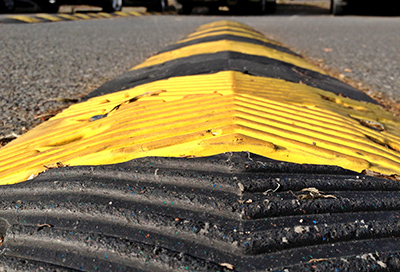Can We Capture Energy from Speed Bumps?
-
-
slice.mit.edu
Filed Under
Recommended
“If you want to capture energy and use it to power something, it’s true that you can get energy out of a speed bump,” says Amos Winter, an assistant professor in MIT’s Department of Mechanical Engineering and director of its Global Engineering and Research (GEAR) Lab. “You need to think about how you transfer that energy, and how much energy you can actually capture.”
A speed bump pushes the car’s wheels upwards, and when it bounces back to the ground, kinetic energy is converted to potential energy absorbed in its shock absorbers. Capturing some of that energy sounds plausible at first blush. Using piezoelectric sensors, you can generate power by converting some of that force into an electrical charge. “You can produce high voltage, but pretty low current,” says Winter. “The energy of the spark of a piezoelectric barbecue lighter, for example, is less than the energy you put into pulling the trigger.”
The core principle involves work: the application of force over a distance. A car’s force multiplied by the distance it depresses the piezos equals the amount of useful work that can be done – and a car tire rolling over a piezo will depress it only a few microns. Winter suggests a more efficient way of capturing that energy. “Instead of making a speed bump, make a speed divot,” he says. “A flat surface that can be depressed easily will sink down when you drive over it and you can use the weight of the car to spin some sort of generator.” Another scenario is a compressible speed bump made of flexible plastic or rubber filled with water. When a car drives over it, water is squeezed out and can be pumped into a water tower high in the air. “You could run that water through a turbine and produce electricity with it,” says Winter.
Such models, of course, require full-size cars, full-size roadways, and full-size water towers. Scaling down the project to exhibit in the school auditorium is another story. The size of the display may be smaller, but the challenge is much larger. “You could construct a small speed bump and push down on it with a section of a car tire to light up an LED,” suggests Winter. “But a model using Hot Wheels cars? Forget it. They’d never deflect the speed bump enough to produce any energy.”
In the end, the most important thing to keep in mind is that creating energy isn’t just about applying force; it all goes back to the principle of work. “You need force multiplied by a distance,” says Winter. “That’s what shock absorbers do, and a more interesting design could be built around that.” He suggests checking out Levant Power, a company founded by Shakeel Avadhany '09 and Zack Anderson '09 to develop and commercialize shock absorber energy recovery.
Authored by Sarah Jensen. Thanks to Jonathan from Atlanta, Georgia, for this question. Visit the MIT School of Engineering’s Ask an Engineer site for answers to more of your questions.








